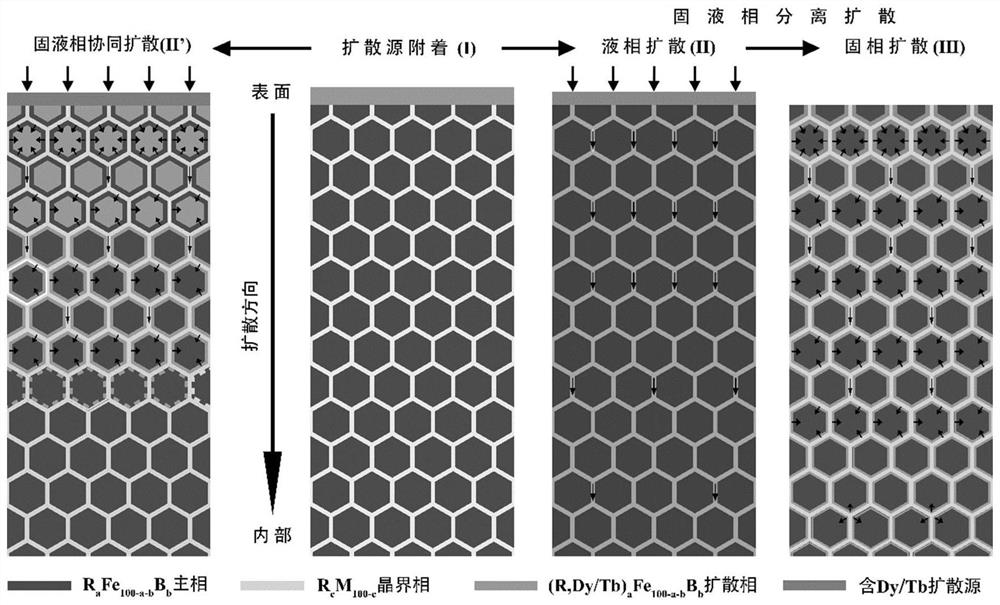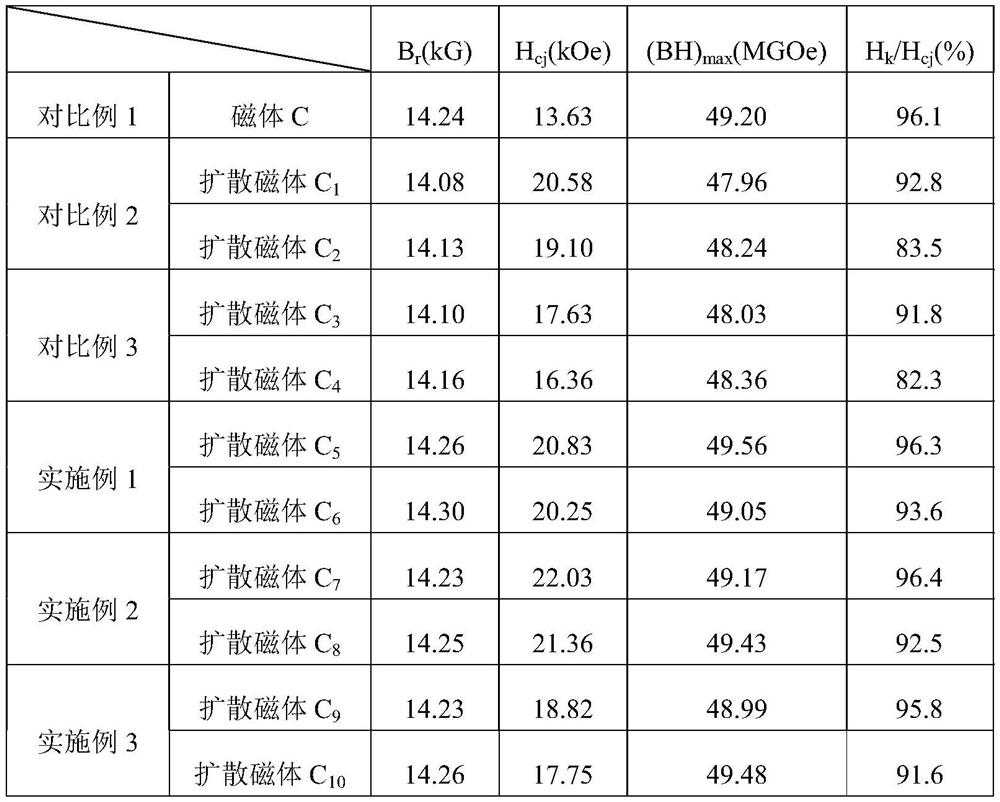Method for preparing high-performance neodymium-iron-boron magnet through solid-liquid phase separation diffusion process
A liquid phase diffusion and NdFeB technology, which is applied in the direction of magnetic objects, magnetic materials, inductors/transformers/magnets, etc., can solve the problems of poor squareness, reduce the mechanical properties of magnets, increase the diffusion depth, etc., and achieve improved uniformity and squareness, save heavy rare earth resources, and increase the effect of diffusion depth
- Summary
- Abstract
- Description
- Claims
- Application Information
AI Technical Summary
Problems solved by technology
Method used
Image
Examples
Embodiment 1
[0048] According to the nominal composition of the main phase alloy A (Pr 20 Nd 80 ) 29 Fe 70 B (wt.%), the nominal composition of auxiliary alloy B is (Pr 20 Nd 80 ) 70 Cu 30 (wt.%), two quick-setting thin strips of components A and B were prepared, subjected to hydrogen crushing and dehydrogenation to obtain coarsely crushed magnetic powder, and then jet milled to obtain a fine powder of 3 μm.
[0049] In the glove box, the two components of A and B are mixed according to the mass ratio of 95:5. After the mass ratio is 95:5, they are fully mixed and oriented and formed in an inert gas protective atmosphere to obtain a green body. The green body is vacuum-packaged for cooling After isostatic pressing, put it into a vacuum sintering furnace for sintering, keep it at a sintering temperature of 1050°C for 2 hours, then pass through argon air cooling, then perform a primary heat treatment at 900°C for 4 hours, and then perform a secondary heat treatment at 450°C. The time ...
Embodiment 2
[0055] According to the nominal composition of the main phase alloy A (Pr 20 Nd 80 ) 29 Fe 70 B (wt.%), the nominal composition of auxiliary alloy B is (Pr 20 Nd 80 ) 70 Cu 30 (wt.%), two quick-setting thin strips of components A and B were prepared, subjected to hydrogen crushing and dehydrogenation to obtain coarsely crushed magnetic powder, and then jet milled to obtain a fine powder of 3 μm.
[0056] In the glove box, the two components of A and B are mixed according to the mass ratio of 95:5. After the mass ratio is 95:5, they are fully mixed and oriented and formed in an inert gas protective atmosphere to obtain a green body. The green body is vacuum-packaged for cooling After isostatic pressing, put it into a vacuum sintering furnace for sintering, keep it at a sintering temperature of 1050°C for 2 hours, then pass through argon air cooling, then perform a primary heat treatment at 900°C for 4 hours, and then perform a secondary heat treatment at 450°C. The time ...
Embodiment 3
[0062] According to the nominal composition of the main phase alloy A (Pr 20 Nd 80 ) 29 Fe70 B (wt.%), the nominal composition of auxiliary alloy B is (Pr 20 Nd 80 ) 70 Cu 30 (wt.%), two quick-setting thin strips of components A and B were prepared, subjected to hydrogen crushing and dehydrogenation to obtain coarsely crushed magnetic powder, and then jet milled to obtain a fine powder of 3 μm.
[0063] In the glove box, the two components of A and B are mixed according to the mass ratio of 95:5. After the mass ratio is 95:5, they are fully mixed and oriented and formed in an inert gas protective atmosphere to obtain a green body. The green body is vacuum-packaged for cooling After isostatic pressing, put it into a vacuum sintering furnace for sintering, keep it at a sintering temperature of 1050°C for 2 hours, then pass through argon air cooling, then perform a primary heat treatment at 900°C for 4 hours, and then perform a secondary heat treatment at 450°C. The time is...
PUM
| Property | Measurement | Unit |
|---|---|---|
| Melting point | aaaaa | aaaaa |
| Particle size | aaaaa | aaaaa |
Abstract
Description
Claims
Application Information
 Login to view more
Login to view more - R&D Engineer
- R&D Manager
- IP Professional
- Industry Leading Data Capabilities
- Powerful AI technology
- Patent DNA Extraction
Browse by: Latest US Patents, China's latest patents, Technical Efficacy Thesaurus, Application Domain, Technology Topic.
© 2024 PatSnap. All rights reserved.Legal|Privacy policy|Modern Slavery Act Transparency Statement|Sitemap


